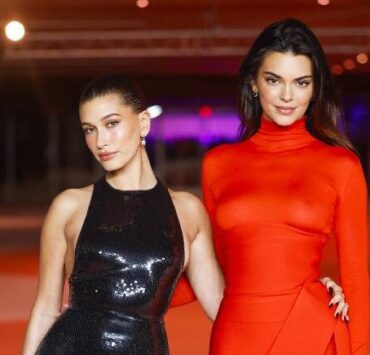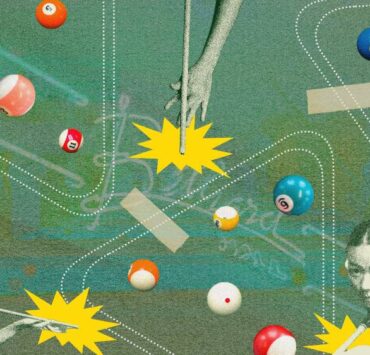Romeo Lee’s raw energy roars through Jay Taruc’s moto-inspired gallery
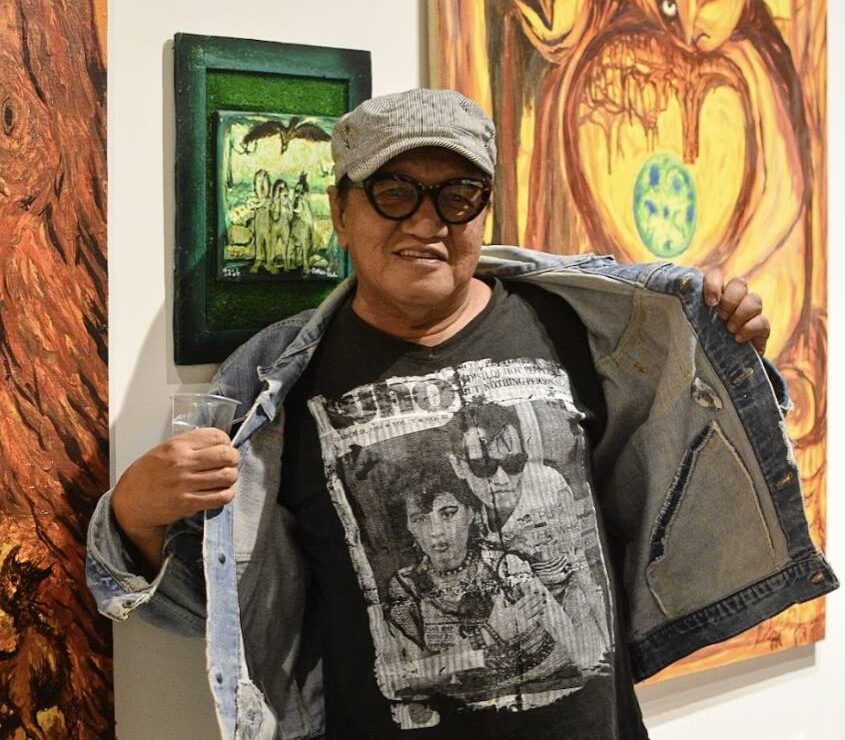
Romeo Lee doesn’t follow rules—he paints over them. Jay Taruc doesn’t run a typical white-wall gallery—he turned a boiler room into Brixton Art Space.
One is a painter, a self-proclaimed ukay-ukay king, mountaineer, and living icon whose visual language refuses to behave. The other, a veteran journalist and creator of the critically acclaimed hit show “Motorcycle Diaries,” is a collector-turned-gallerist who transformed a forgotten corner of Kapitolyo into the raw, beating heart of its emerging art scene.
They come from different orbits, but at Brixton Art Space, their worlds collide—with noise, instinct, and no apologies. In this two-on-one conversation, Lee and Taruc talk chaos, clarity, and why the most unforgettable art isn’t manicured or over-curated—it’s lived, with punk rock grit and piston-powered energy.
Coming from the world of journalism and television, what drew you to open Brixton Art Space in Kapitolyo—and why contemporary art?
Jay Taruc (JT): I am a journalist who happens to love art. A fellow TV celebrity once introduced me to local contemporary art—my friend Kim Atienza. I used to cover the Manila area for news, and I would often visit Kim’s old Syquia Apartment in Manila, where I was exposed to his fantastic collection over coffee.
I think being a journo who loves art was purely coincidental, but over time, my love for art grew and became a passion that has lasted for decades. I still enjoy buying art. I still enjoy going to shows.
What’s the origin story behind Brixton Art Space?
JT: Brixton Art Space is truly a blessing—one that came just last year after decades of praying for a gallery of our own.
I’ve been a long-time fan of art, having started collecting contemporary works in the late 1990s. Over the years, I found myself becoming close friends with artists and gallery owners, naturally immersing deeper into the local art scene.
Last year, after careful thought and reflection, we decided to convert our TV production office into an art space. There was something about the energy of the place—its location, its spirit—that felt right.
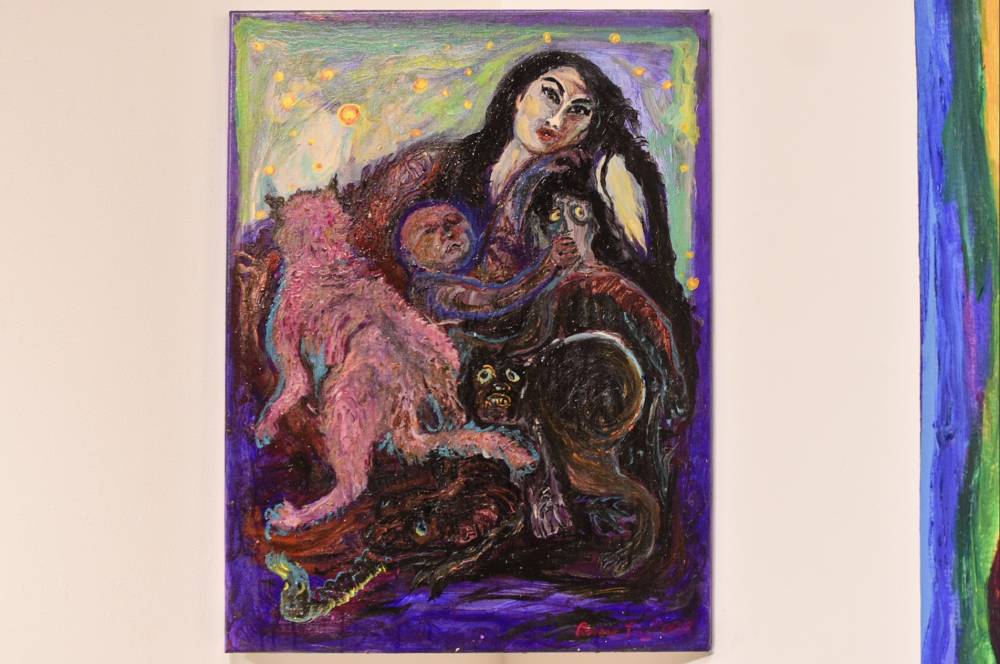
The space is housed in a building from the late 1950s, which once served as home to National Bookstore, Marks & Spencer, and other businesses that recognized the value of its central location.
Our gallery room—now Brixton Art Space—was once a literal ‘boiler room’ used by the previous tenant. We chose to honor the space’s past by preserving elements of its history, leaving behind traces that tell its story. We wanted it to feel honest, raw, and full of memory.
What is it about Romeo Lee’s practice—or even just his persona—that made him the right artist to spotlight in a major solo show at Brixton, especially in the lead-up to your first anniversary this August?
JT: Romeo Lee is an icon in the local contemporary art scene. He was one of the first artists I collected—and I remain a fan to this day. His work is raw, brutally honest, and I love that it’s fueled by a deep love for rock ‘n’ roll.
Having Lee do a solo show has always been at the top of our wishlist. And honestly, I think this part of Kapitolyo needs that kind of energy.
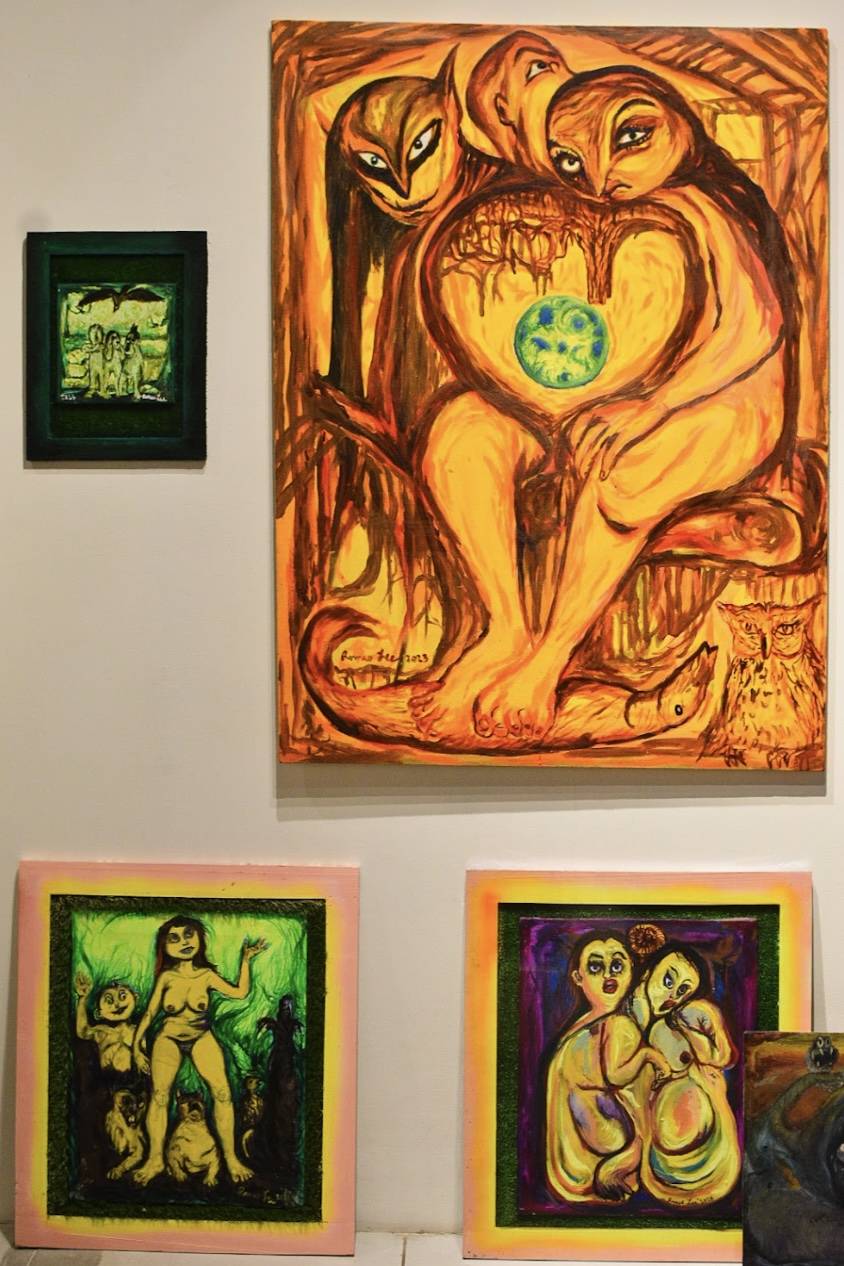
Romeo, can you tell us about the body of work you chose to exhibit as part of your solo show Painter Lee at Brixton Art Space?
Romeo Lee (RL): Wala naman talagang tema o specific na topic—karambola lang talaga sa layout at pagsabit ng mga painting. Ang ganda kasi maraming artworks, kaya ang daming puwedeng paglaruan.
Your visual language is instantly recognizable—very punk rock, raw, sometimes grotesque, oftentimes humorous yet deeply expressive. What influences have shaped your iconography and aesthetic over the years?
RL: Bilang ‘ukay-ukay king,’ nakakasalamuha ako ng sari-saring klase ng tao. Sa UP Mountaineers naman, kung saan-saan ako napapadpad—madalas, sa hatinggabi, kung anu-anong nilalang ang nasisilayan ko. Bata pa lang ako sa Bicol, naglalako na ako ng paninda. Kaya sanay akong makakita ng iba’t ibang karakter—minsan, habang kausap ko, tumutulo na ‘yong laway nila sa kakadaldal! Sari-saring itsura, kilos, pati na hayop ang naipon sa memorya ko. Isa sa mga paborito kong inspirasyon? Mga audience sa concert—iba rin ang energy nila habang nagpe-perform ako.
In your own words, who is Romeo Lee—not just the artist, but the person behind the distinct style?
RL: Kung ano ako, ‘yon na ‘yon—I am what I am. Marami lang akong idea dahil sa mga music at pelikulang napapanood ko, pati na rin sa mga karanasan sa buhay. Mga pelikula tulad ng “Tommy,” ‘yong cult classic rock musical horror film na “Phantom of the Paradise,” “Grease,” at “Empire of the Sun”—lahat ‘yan naka-embed sa utak ko. Lahat ‘yan nagbibigay ng hugis sa mga gawa ko.
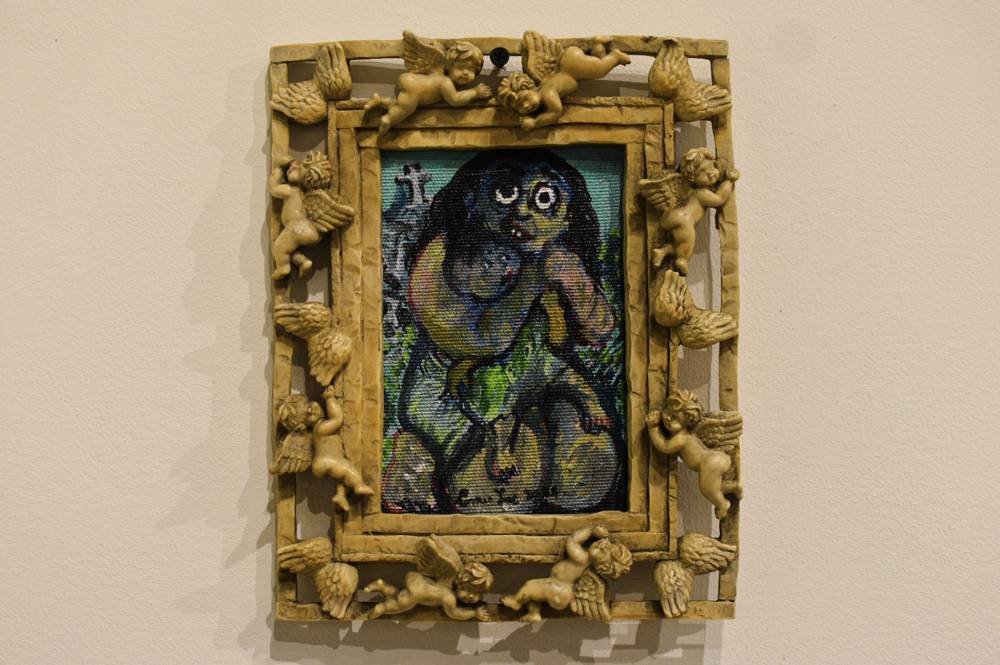
As someone born to a Cantonese migrant father and a Filipina mother, how has your Chinese-Filipino identity influenced your worldview and the way you approach art?
RL: Pakiramdam ko, malaki ang naitulong sa akin ng Chinese brush at pintura noong bata pa ako. Lagi ko kasi ‘yang nakikita sa mesa namin—pula dayon ang raket ng mga magulang ko sa Bicol. Pula ang pintura, at parang may bingo-style setup kung saan pipili ka ng numero, tapos pipintahan mo ito.
Kapag walang customer, ginagamit ko ‘yong brush at pintura. Doon yata nagsimula ang hilig ko sa pagdo-drawing at pagpipinta.
What usually compels or stimulates you to paint? Are your works driven by instinct, memory, mood, or something else entirely?
RL: It really depends on my mood at kailangan may music na background habang nag pipinta ako. Mga banda na madalas kong pinapakinggan—Bee Gees, kasi malamig sa tenga, tapos mga punk bands din tulad ng The Clash, Boomtown Rats, at ‘yong 1977 album ng Talking Heads.
Speaking of your playlist, who or what have been your biggest influences—not only in art, but also in music, cinema, pop culture, and life in general?
RL: Syempre, ‘yong mga banda na trip ko mula pa ‘50s, ‘60s, ‘70s, hanggang ‘80s—‘yan talaga ‘yong may bigat para sa akin. Noong ‘90s na, medyo nababaduyan na ako sa mga tugtugan. Pero noong pumutok ang punk, grabe ang epekto sa akin. Naging wild bigla pati mga artwork ko—wala nang rules, basta banat lang. Nadala rin sa pananamit ko, pati attitude at lifestyle. Punk talaga ang tumulak sa akin para maging malaya.
Nag-resonate talaga sa akin ‘yong attitude at tunog ng mga punk rock na banda—parang natural na high kapag nagpipinta ako! Lalo na ‘yong buong LP ng Talking Heads na 77—grabe ‘yong epekto. May kakaibang groove at kabaliwan na parang nagtutulak sa akin na ilabas lahat ng enerhiya ko sa canvas.
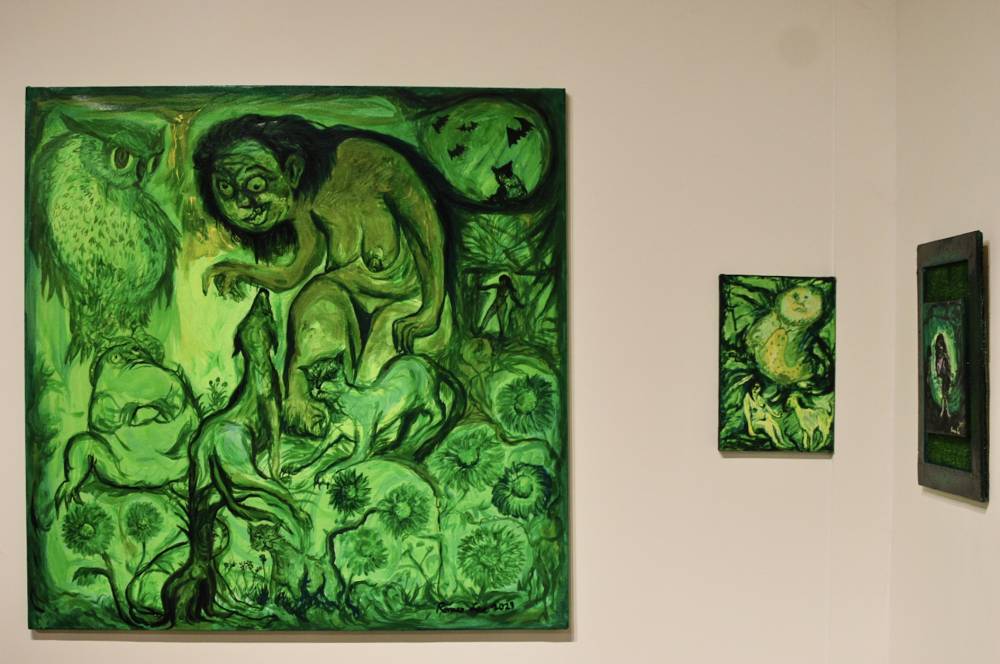
Jay, what’s your vision for Brixton Art Space?
JT: My vision for Brixton Art Space in the next few years is simple: to invite artists that we genuinely like—not the other way around. We want to offer something different from what’s currently happening in the art scene.
Yes, we embrace our roots—art that’s moto-leaning, motorcycle culture-inflected—but we also want to move beyond that. Ang lawak ng eksena. And we’re eager to explore more of it.
Romeo, your last solo show was years ago. Why did you agree to do a solo show at Brixton Art Space? What is it about Jay as a collector and gallerist that makes it special for you?
RL: Napapansin ko kasi ngayon, maraming galleries ang puro favorite na lang nila o ‘yong mga artist na sigurado nang mabenta. Paulit-ulit, predictable. E sa totoo lang, nakakabore na ‘yon.
Sa Brixton, ibang klase ang crowd—karamihan bago, may sariling taste, hindi sunod lang sa uso. Sa ibang galleries kasi, kung ano ‘yong patok sa bentahan, ‘yon at ‘yon din ang nilalagay. Ang dami na ring artist na, para sa akin, sobrang baduy na.
Noong nagbukas kami sa Brixton, ang saya—maraming friends ko ang dumating, mga taong alam ko na may tunay na appreciation sa art. Hatak ko ‘yung crowd, pero solid ‘yung energy.
At tuwing naiisip ko ang Brixton, automatic, naaalala ko ‘yong kanta ng The Clash—”Guns of Brixton.”
Lastly, Romeo, why are you an artist?
RL: Maybe life has left me with no choice but to be an artist.














